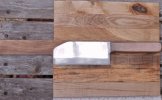i know the guy on that vid you mentioned, his username is saltydog55252 on youtube. he's on other kitchen knife forums that i am on. that guy has the most awesome knives. he has in own restaurant. definitely knows what he's talking about.
here you go, his channel on youtube:
http://www.youtube.com/user/saltydog55252
it's a whole different world with kitchen knives, as most folks here will realize. =D
15 degrees on each side (30 degrees inclusive) is the norm in japanese knives. some even take it further to way insane angles but 30-32 degrees gives you the most versatility in both cutting and edge retention. but with other considerations such as steel hardness, geometry, knife skills, and then the cutting board, your mileage may vary. =D
cutting boards matter, which is why most kitchen knife knuts will go to theboardsmith for their boards.
endgrain is best, but edgegrain is okay. no bamboo(it's not even wood! it's a grass lol), hardwood is the best (maple and cherry is usually the norm, nothing too hard like ironwood). plastic is okay, but never stone or glass. there are boards now that are made with rubber, sani tuff is a pretty good choice for synthetic boards.
and then there's the matter of the kind of knife you're gonna use, the proper knife for every application.
can't exactly do fine cuts like brunoise, julienne, and whatnot on a boning knife. you could but it will be very clumsy.
or cutting sushi with a bread knife. that would be just plain silly.
i'm a culinary arts graduate so i think i know a thing or two. =D

